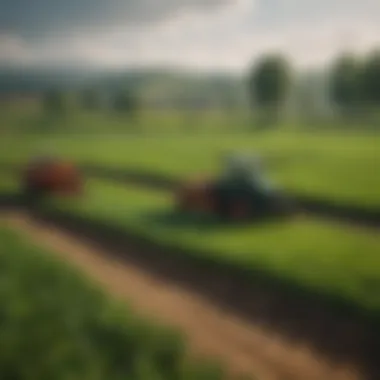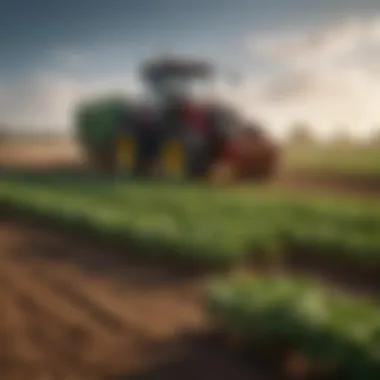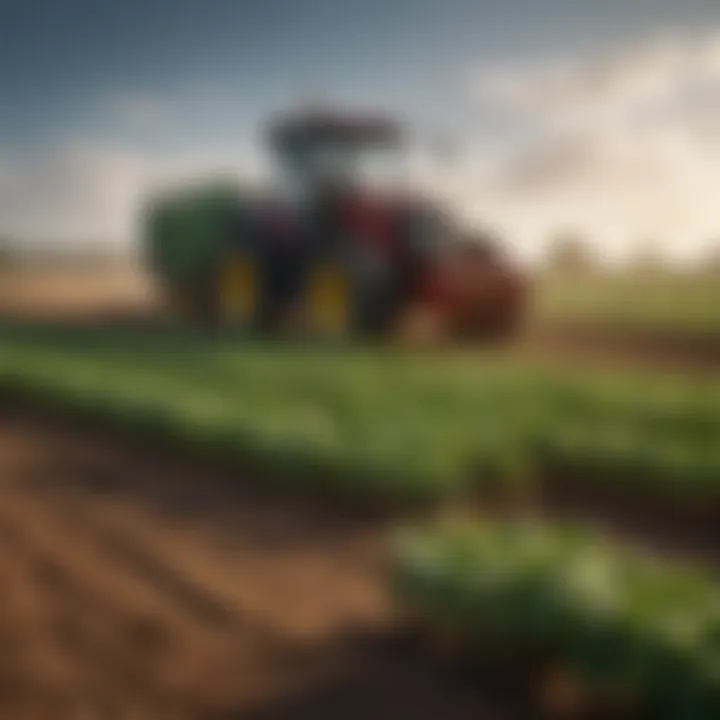Understanding the Sustainable Development Goals in Agriculture


Intro
The Sustainable Development Goals, also known as SDGs, represent a form of understanding. This initiative originates from the United Nations, aiming to create a better world by 2030. Agriculture plays a pivotal role within these goals. It is essential for food security, economic growth, and environmental sustainability.
As we dive into the SDGs specifically relevant to agriculture and agronomy, it is important to understand their framework and implications. These objectives endeavor to balance productivity with sustainability, addressing various challenges faced by farmers and agronomists around the globe. The transition to sustainable practices in agriculture depends on collaboration, innovative techniques, and successful integration of these goals into farming strategies.
Topic Overview
Definition and Importance
The Sustainable Development Goals encompass 17 global objectives. Each goal addresses specific issues, such as poverty, gender equality, and climate action. The connection between agriculture and these goals is significant, as sustainable agriculture is crucial for achieving many of them. For instance, Goal 2 focuses on zero hunger, emphasizing the necessity of efficient farming practices to feed a growing population, while also improving social equity and environmental responsibility.
Brief History and Evolution
The United Nations adopted the SDGs in 2015 as a successor to the Millennium Development Goals. They marked a shift towards inclusivity, recognizing the interconnectedness of various sectors, including agriculture. Over time, agriculture has evolved to face pressing challenges such as climate change, land degradation, and shifting market demands. The SDGs emerged as a structured response to these challenges, urging a global movement towards sustainable practices.
Key Techniques and Innovations
Sustainable Farming Practices
Sustainable farming practices are methods that enhance crop productivity while conserving natural resources. Examples include:
- Crop rotation: This practice helps maintain soil health and minimizes pest buildup.
- Integrated pest management: Utilizing biological control methods reduces the reliance on chemical pesticides.
- Agroforestry: Mixing trees with crops can improve biodiversity and provide additional income sources for farmers.
- Organic farming: This practices aims to reduce chemical input, thereby promoting environmental health.
Advanced Agronomic Technologies
Technological advancements are crucial for the evolution of agriculture. Innovations such as precision agriculture optimize resource use. Technologies like drone mapping and soil sensors enhance decision-making efficiency. Other relevant innovations include:
- Biotechnological crops: These crops possess traits like pest resistance or drought tolerance.
- Climate-smart agriculture: Practices that increase resilience against climate-related challenges.
- Use of data analytics: Analysis of agricultural data to improve decision making and productivity.
Practical Applications
Step-by-Step Guides
Implementing sustainable practices can be a structured process. It often begins with:
- Assess current practices and resources: Understand the existing agricultural system and identify areas for improvement.
- Research suitable techniques: Explore various sustainable practices based on the local context and environmental conditions.
- Engage with stakeholders: Involve community members, local organizations, and policymakers for support.
- Apply sustainable practices: Implement chosen techniques, monitoring their effectiveness.
- Review and adapt: Regularly assess outcomes and refine practices accordingly.
Case Studies or Real-World Examples
Numerous case studies exemplify the integration of SDGs into agriculture. One notable instance is the work done by the International Rice Research Institute in the Philippines. They developed rice varieties that require less water, enhancing food security while conserving resources.
Another example can be seen in Brazil, where agroecological techniques have been adopted to improve biodiversity and economic return for smallholder farmers. These real-world examples showcase how SDGs can translate into tangible benefits in agricultural settings, ultimately guiding future pathways for sustainable development.
By understanding and integrating the Sustainable Development Goals into agriculture, we open pathways to a more sustainable future. In the upcoming sections, we will explore the challenges and opportunities presented by these goals, thus providing a clearer perspective for stakeholders in the agriculture sector.
Prolusion to Sustainable Development Goals
The Sustainable Development Goals, established by the United Nations in 2015, are a vital framework designed to guide global efforts toward a more sustainable future. In the context of agriculture and agronomy, these goals serve as a key reference point for assessing sustainability practices, promoting innovation, and addressing numerous challenges faced by the farming community. The significance of the Sustainable Development Goals extends beyond mere compliance; they encapsulate critical aspects of social, economic, and environmental sustainability that contribute to the resilience of agricultural systems.
Definition and Origin of SDGs
The Sustainable Development Goals consist of 17 interconnected goals aimed at addressing global issues such as poverty, inequality, and climate change. These goals arose from a collaborative process involving member states, civil society, and various stakeholders, culminating in the adoption of the 2030 Agenda for Sustainable Development. The origins of the SDGs can be traced back to the Millennium Development Goals, which focused on addressing pressing global challenges from 2000 to 2015. The transition to SDGs marks a more comprehensive and inclusive approach, recognizing that sustainable development requires multisectoral strategies and localised solutions.
Importance of SDGs in Global Context
The importance of the Sustainable Development Goals cannot be overstated, particularly regarding their potential to reshape agriculture practices worldwide. Integrating SDGs into agricultural strategies provides numerous benefits, such as:
- Enhanced Food Security: By prioritizing sustainable farming methods, SDGs can lead to improved agricultural productivity, ensuring that food supply meets the growing demand.
- Economic Growth: Sustainable agricultural practices promote long-term economic stability, benefiting both farmers and the broader economy.
- Environmental Protection: Emphasizing biodiversity conservation and sustainable resource management focuses attention on minimizing environmental degradation.
Furthermore, the global context of SDGs elevates the discourse surrounding agriculture. Achieving these goals necessitates international cooperation, enabling countries to share best practices and resources. This collaborative spirit fosters innovation and adaptation in agricultural practices, making it essential for stakeholders in the agricultural sector to engage with the SDGs purposefully.
The Sustainable Development Goals are not just aspirations but rather a call to action for stakeholders at all levels, from policymakers to farmers, aiming to create a more sustainable agricultural future.
SDGs Overview
The Sustainable Development Goals (SDGs) provide a shared agenda for nations to work collectively towards a more sustainable and equitable future. In agriculture, understanding these goals is crucial for impacting food systems, environmental stewardship, and social well-being. The SDGs not only guide government policy but also influence the actions of farmers, NGOs, and private businesses. By integrating SDGs into agricultural practices, all stakeholders can contribute to a holistic framework for sustainability.


Comprehensive List of SDGs
The 17 Sustainable Development Goals encompass a broad range of issues. Here is a brief outline of these goals:
- No Poverty: End poverty in all its forms everywhere.
- Zero Hunger: End hunger, achieve food security and improved nutrition, and promote sustainable agriculture.
- Good Health and Well-Being: Ensure healthy lives and promote well-being for all at all ages.
- Quality Education: Ensure inclusive and equitable quality education and promote lifelong learning opportunities for all.
- Gender Equality: Achieve gender equality and empower all women and girls.
- Clean Water and Sanitation: Ensure availability and sustainable management of water and sanitation for all.
- Affordable and Clean Energy: Ensure access to affordable, reliable, sustainable, and modern energy for all.
- Decent Work and Economic Growth: Promote sustained, inclusive, and sustainable economic growth, full and productive employment, and decent work for all.
- Industry, Innovation, and Infrastructure: Build resilient infrastructure, promote inclusive and sustainable industrialization, and foster innovation.
- Reduced Inequalities: Reduce inequality within and among countries.
- Sustainable Cities and Communities: Make cities and human settlements inclusive, safe, resilient, and sustainable.
- Responsible Consumption and Production: Ensure sustainable consumption and production patterns.
- Climate Action: Take urgent action to combat climate change and its impacts.
- Life Below Water: Conserve and sustainably use the oceans, seas, and marine resources for sustainable development.
- Life on Land: Sustainably manage forests, combat desertification, halt and reverse land degradation, and halt biodiversity loss.
- Peace, Justice, and Strong Institutions: Promote peaceful and inclusive societies for sustainable development, provide access to justice for all, and build effective, accountable institutions.
- Partnerships for the Goals: Strengthen the means of implementation and revitalize the global partnership for sustainable development.
Understanding these goals provides the groundwork for more sustainable agricultural policies. While each goal holds importance, some have direct implications for farming practices, food systems, and rural development.
Interrelations Among the SDGs
The SDGs are interconnected, meaning progress in one goal often influences the attainment of others. For instance, achieving Zero Hunger directly contributes to Good Health and Well-Being by improving nutrition levels. Conversely, improvements in Quality Education can enhance agricultural productivity by equipping farmers with essential skills.
Among the intricate relationships, several key connections emerge:
- Sustainable Agriculture and Climate Action: Responsible farming practices can reduce emissions while enhancing resilience against climate change.
- Gender Equality and Economic Growth: Empowering women in agriculture leads to better economic outcomes and improved food security.
- Clean Water and Responsible Consumption: Sustainable agricultural practices help preserve water resources, benefiting both farmers and communities.
These interrelations highlight the need for integrated strategies that recognize the complexities of agricultural systems. By focusing on interconnected outcomes, policymakers can create more effective frameworks to advance sustainable development in agriculture.
Agriculture's Role in Achieving SDGs
Agriculture is a cornerstone for achieving the Sustainable Development Goals (SDGs). Its influence extends beyond food production. It affects health, economy, and environmental sustainability. Given the rising global population, ensuring food security is paramount. Agriculture transforms natural resources into nutritional food, making it critical to several SDGs. Moreover, the sector employs millions and generates income for a substantial portion of the global population.
The role of agriculture in achieving SDGs cannot be overstated. It contributes directly to several key goals, particularly Goal 2: Zero Hunger. However, the contribution does not stop there. Sustainable agricultural practices can support economic growth (Goal 8), promote responsible consumption and production (Goal 12), and even combat climate change (Goal 13).
Thus, understanding agriculture's multifaceted role offers insights into effectively implementing SDGs. A focus on sustainable practices and innovation can drive progress while addressing challenges that often hinder advancement in the sector. This engagement ultimately fosters resilience and stability in communities worldwide.
Direct Impacts on Food Security
Food security is a primary concern globally. Sustainable agriculture is critical for ensuring that all individuals have access to sufficient, safe, and nutritious food. The reliance on sustainable methods enhances agricultural productivity and enhances resilience against climate change and other shocks. Diverse cropping systems, reduced reliance on chemical inputs, and soil health improvement techniques contribute to greater food availability, particularly in vulnerable communities.
Moreover, agriculture has a significant impact on nutrition. By diversifying crops, farmers can provide more nutritious options, improving overall health. Reducing food waste through better practices can also aid in tackling hunger. With SDGs focusing on eliminating hunger, sustainable agricultural practices directly support this ambition.
"Food security is not just about availability; it's also about access and nutrition. Sustainable agriculture helps address all these dimensions."
Sustainable Practices in Agronomy
In agronomy, sustainable practices are essential for fostering an environmentally sound agricultural system. Techniques such as crop rotation, intercropping, and organic farming enhance soil fertility and biodiversity. These methods ensure that the agricultural landscape remains productive without overexploiting resources.
The integration of technology in sustainable practices also plays a vital role. Precision agriculture, for example, allows farmers to use data and technology to optimize inputs. This approach minimizes waste and maximizes productivity while reducing the environmental footprint. Awareness and education about sustainable practices among farmers are critical for widespread adoption.
Investing in research and development fosters innovation in agronomy. Technologies such as drought-resistant crops are vital. These not only increase yield but also provide security in times of environmental stress. Sustainable farming ensures that resources can be used without compromising the needs of future generations.
Challenges in Implementing SDGs in Agriculture
The challenges in implementing Sustainable Development Goals (SDGs) within agriculture are numerous and significant. Understanding these barriers is essential for farmers, policymakers, and stakeholders eager to foster sustainable agricultural practices. Addressing economic barriers, social and cultural resistance, and environmental concerns is critical to the success of these goals.
Economic Barriers
Economic factors often pose a substantial challenge to the implementation of SDGs in agriculture. Many smallholder farmers operate on tight margins and lack access to necessary financial resources. Without adequate funding, it can be difficult to adopt new practices that align with SDGs. Moreover, the initial costs associated with transitioning to sustainable farming techniques can be prohibitive. High-quality seeds, modern equipment, and sustainable technologies often come with steep prices.
Furthermore, there is a need for investment in agricultural infrastructure. This includes access to irrigation systems, storage facilities, and transport networks. Such developments require governmental and private-sector support, which may not be readily available. Without these investments, achieving SDGs related to food security and sustainable agriculture becomes increasingly complex.
"Economic sustainability is the cornerstone of achieving the Sustainable Development Goals in agriculture. Without a stable financial framework, progress remains stunted."
Social and Cultural Resistance
Cultural and societal factors can significantly impact the acceptance of SDGs in agricultural practices. Many communities have traditional farming methods that have been passed down for generations. Changing these practices can lead to resistance from farmers who are reluctant to abandon their heritage or who lack understanding of the benefits of sustainable practices.
In some cases, gender roles also contribute to this resistance. Women often hold the key roles in agricultural production, yet they may not have equal access to resources, information, or decision-making processes. Empowering these women is essential in promoting change and aligning with SDGs on gender equality and sustainable agriculture.
Establishing educational programs can be effective in alleviating some of this resistance. By educating farmers and community members about the long-term benefits of sustainable practices—such as improved yields and environmental resilience—there may be greater acceptance of these changes.
Environmental Impact Concerns
While pursuing SDGs in agriculture, it is essential to consider the environmental impact of agriculture itself. Intensive farming practices can lead to soil degradation, deforestation, and loss of biodiversity, contrary to the goals of sustainability. The overuse of fertilizers and pesticides can lead to pollution, adversely affecting ecosystems and human health.
Addressing these environmental concerns requires a shift in practice. Incorporating agroecology principles can promote biodiversity and reduce dependency on harmful chemicals. Importantly, there needs to be an understanding that environmental issues may not be immediately visible, but they have long-term implications for agricultural productivity.
Additionally, climate change poses a significant challenge to achieving SDGs in agriculture. Farmers may face shifting weather patterns, leading to crop failures and food scarcity. Ensuring resilience through sustainable farming techniques becomes paramount.


In summary, tackling these challenges requires a multifaceted approach that involves economic support, education, and sustainable practices. When stakeholders collaborate to address these barriers, opportunities for sustainable growth in agriculture can emerge.
Opportunities Presented by SDGs
The integration of the Sustainable Development Goals (SDGs) into agriculture and agronomy opens up numerous opportunities. These goals serve not only as a framework for sustainable farming practices but also as a catalyst for innovation and collaboration. In this section, we’ll explore two key aspects: innovation in agricultural practices and collaboration across sectors.
Innovation in Agricultural Practices
Innovation is at the forefront of achieving the SDGs in agriculture. New technologies and approaches enhance productivity while minimizing negative environmental impacts. For instance, precision agriculture allows farmers to apply inputs like water and fertilizers more efficiently. This technology uses data analytics and remote sensing to optimize crop yields and reduce waste.
Additionally, sustainable farming techniques such as agroecology and organic farming contribute to biodiversity and soil health. These practices not only align with the SDGs but also promote long-term food security.
Furthermore, innovations in biotechnology can improve crop resilience against pests and climate change. Crops that are genetically modified to withstand extreme weather can lead to more stable food supplies. This is crucial as global populations increase and climate conditions become more erratic.
In summary, the adoption of innovative practices is essential for meeting the agricultural targets of the SDGs. By investing in research and promoting technology adoption, farmers can contribute to a sustainable future.
Collaboration Across Sectors
Collaboration among various stakeholders is vital for advancing the SDGs in agriculture. It creates synergies that can lead to more effective solutions. Governments, NGOs, and the private sector must work together to share knowledge and resources.
"Collaboration is key to unlocking the potential of sustainable agriculture, ensuring food security for future generations."
Institutions like the Food and Agriculture Organization of the United Nations (FAO) facilitate partnerships that bring different parties to the table. They foster discussions that can lead to better policies and frameworks that support sustainable farming.
Involving the private sector helps bring in investment and expertise. Companies can introduce sustainable practices in their supply chains, benefiting both producers and consumers. This shared responsibility is crucial in achieving goals related to poverty, hunger, and climate actions.
Grassroots initiatives also play a significant role. Local community groups can implement sustainable practices that reflect their unique contexts. Their involvement ensures that solutions are tailored and effective.
Stakeholder Engagement and Participation
Stakeholder engagement and participation play a crucial role in the successful implementation of the Sustainable Development Goals (SDGs) within the agricultural sector. This section highlights the necessity of involving diverse groups in the decision-making processes related to agriculture and agronomy. When various stakeholders come together, they can share their insights, experiences, and resources, ultimately leading to more effective strategies for sustainable practices.
Role of Governments
Governments are fundamental in steering the direction of agricultural policies and practices towards sustainability. They have the power to create frameworks that support the integration of SDGs. This includes formulating laws that incentivize sustainable farming practices and providing funding for research and development.
Furthermore, governments can facilitate dialogues among different stakeholders, including farmers, businesses, and NGOs. By bridging gaps between these groups, they help in the dissemination of valuable information on sustainable techniques and technologies. This collaboration can improve food security, enhance environmental stewardship, and contribute to economic growth.
Influence of NGOs and Civil Society
Non-governmental organizations (NGOs) and civil society groups significantly influence the agricultural sector's engagement with SDGs. They often serve as catalysts for change, advocating for policies that promote sustainability and social equity. NGOs can mobilize communities to participate in sustainable practices by raising awareness about environmental and social issues.
Through grassroots campaigns and educational programs, these organizations empower farmers to adopt innovative practices. Their local knowledge and networks can help identify challenges specific to various communities, allowing for tailored solutions. This engagement fosters a sense of ownership among stakeholders, leading to long-lasting change within the sector.
Private Sector Contributions
The private sector has an essential role in realizing the objectives of SDGs in agriculture. Companies can invest in sustainable technologies that enhance productivity and minimize environmental impacts. Collaborations between corporations and farmers can lead to innovative solutions that address issues such as water scarcity, soil degradation, and biodiversity loss.
Moreover, businesses can engage in corporate social responsibility initiatives aimed at supporting sustainable agriculture. This can involve funding local farmers, implementing fair trade practices, and contributing to community development projects. By aligning their goals with the SDGs, private sector actors not only aim for profit but also contribute to broader societal goals.
Monitoring and Evaluating Progress on SDGs
Monitoring and evaluating progress on the Sustainable Development Goals (SDGs) is critical for ensuring that agricultural practices align with global sustainability objectives. The agriculture sector significantly influences both environmental stewardship and socio-economic stability. Thus, a structured approach to measuring success is essential. The importance of monitoring not only lies in tracking advancements but chiefly revolves around identifying gaps and areas needing improvement.
Effective monitoring allows stakeholders to make informed decisions. It involves the collection and analysis of data relevant to specific targets within agricultural and agronomic contexts. When stakeholders are equipped with accurate insights, they can adapt strategies promptly. This fosters a dynamic environment where adjustments can lead to enhanced results.
Moreover, transparent monitoring processes build trust among stakeholders, including governments, farmers, and NGOs. It creates a collaborative community where everyone is informed about progress and challenges. Acknowledgment of achievements becomes easier, and setbacks can be addressed collectively.
Finally, monitoring serves as a critical foundation for accountability. It compels stakeholders to fulfill their commitments towards achieving SDGs in agriculture, ensuring that practices remain sustainable and beneficial for future generations.
Key Performance Indicators in Agriculture
Key Performance Indicators (KPIs) in agriculture are specific metrics used to evaluate progress towards the SDGs. These indicators allow for quantifiable tracking of success and help illustrate the effectiveness of implemented strategies. Some essential KPIs include:
- Crop yield: Measuring the quantity and quality of food produced.
- Soil health metrics: Evaluating soil carbon content and nutrient levels, vital for sustainability.
- Water usage efficiency: Assessing the efficiency of irrigation practices.
- Income levels of farmers: Monitoring economic viability for those within the agricultural sector.
The adoption of tailored KPIs is crucial as they provide clarity and focus. Employing a variety of these indicators helps to capture comprehensive data, which aids in formulating policies and planning future agricultural activities.
Assessment Methodologies


Assessment methodologies are systematic approaches to evaluating the effectiveness of agricultural practices in relation to the SDGs. These methodologies help to provide trustworthy evidence of progress. Common assessment methodologies may include:
- Surveys and questionnaires: Gathering data directly from farmers and stakeholders regarding practices and challenges.
- Remote sensing technologies: Utilizing satellite imagery to monitor land use and crop performance.
- Participatory assessments: Involving local communities in gathering insights on agricultural impacts.
- Data triangulation: Combining various data sources to enhance accuracy and depth of analyses.
Selecting appropriate methodologies is key to obtaining reliable information. It allows for engagement with local contexts and adapts assessments to regional challenges. Through comprehensive assessments, stakeholders can identify successful strategies and areas where further efforts are needed to support sustainable agriculture.
Monitoring and assessing progress in agriculture allows for not just accountability but also continuous improvement towards achieving the Sustainable Development Goals.
Case Studies: Successful Integration of SDGs
The integration of Sustainable Development Goals (SDGs) into agriculture offers a blueprint for improving efficiency and resilience within the sector. Case studies exemplify how diverse farming systems can successfully implement these goals. They demonstrate the potential for positive change when innovative approaches are used alongside established knowledge. Furthermore, these examples provide valuable insights into both the practical challenges and effective solutions encountered by farmers.
Innovative Farming Techniques
Innovative farming techniques are critical for meeting the objectives set by the SDGs. One approach is precision agriculture. This method utilizes data analytics, sensors, and GPS technology to enhance productivity. Farmers can monitor fields closely, applying water, fertilizers, or pesticides exactly where they are needed. This leads to reduced waste and increased yields, supporting SDG 2, which focuses on zero hunger.
Another notable technique is intercropping. This involves planting multiple crops in the same field. For example, combining legumes with cereals can improve soil health and increase crop output. The method aligns with SDG 15, which emphasizes life on land, promoting biodiversity and soil fertility.
"Innovative farming techniques can not only increase productivity but also promote environmental sustainability."
These techniques also bolster climate resilience. For instance, agroforestry, which integrates trees with crop and livestock systems, helps mitigate climate change effects while restoring degraded lands. By adopting such practices, farmers can contribute significantly to achieving the overarching goals of the SDGs.
Sustainable Community Projects
Sustainable community projects play a vital role in fostering agricultural sustainability and enhancing local resilience. One example is community-supported agriculture (CSA). In CSA programs, farmers and consumers form partnerships that ensure local produce reaches consumers while offering a stable income for farmers. This model supports SDG 12, which aims for responsible consumption and production.
Another project worth noting is the establishment of community gardens. These gardens not only provide fresh produce but also serve educational purposes, teaching local populations about sustainable agriculture practices. They encourage community involvement and empower marginalized groups in food production, directly addressing SDG 10, which seeks to reduce inequality.
Additionally, farmer cooperatives have been successful in various regions. By pooling resources, farmers can access better tools, seeds, and markets. This collaborative approach is especially important for smallholder farmers, enabling them to scale operations and contribute positively to local and global food systems, which aligns with multiple SDGs.
In summary, the application of innovative farming techniques and the success of sustainable community projects exemplify the pathways available to achieve the Sustainable Development Goals in agriculture. They not only illustrate the beneficial outcomes that can be reached but also emphasize the need for adaptability and collaboration among stakeholders for sustainable development.
Future Pathways for Sustainable Agriculture
The concept of sustainable agriculture is evolving rapidly, and understanding its future pathways is essential for agricultural stakeholders. As the world faces challenges such as climate change, population growth, and food insecurity, innovations in farming practices must be encouraged. This section focuses on emerging trends and technologies, as well as policy recommendations, that can guide agriculture towards a more sustainable future.
Emerging Trends and Technologies
Emerging trends in agriculture signal a shift toward greater sustainability and efficiency. Some of the key trends include:
- Precision Agriculture: This approach uses technology to monitor field variability in crops. Tools such as GPS and IoT devices collect data that help farmers make informed decisions.
- Vertical Farming: Growing crops in vertically stacked layers maximizes space and reduces the area of land needed for cultivation. This method is especially beneficial in urban areas.
- Biotechnology: Genetic modification and CRISPR technology can enhance crop resilience and productivity. These innovations hold promise for reducing dependency on chemical inputs.
- Agroecology: A holistic approach that combines local knowledge with scientific research. It promotes biodiversity and improves sustainability while considering social contexts.
In addition to these trends, automation through robotics is increasingly prevalent. Drones, autonomous tractors, and robotic harvesters improve efficiency and reduce labor costs.
"Sustainable agriculture requires a blend of traditional practices and modern innovations to address today’s global challenges."
These technologies not only boost productivity but also reduce the ecological footprint of farming. Integrating these trends can create a resilient agricultural system focused on long-term sustainability.
Policy Recommendations for Sustainable Development
To effectively promote sustainable agriculture, robust policies must be put in place. Here are key recommendations that can support the transition:
- Incentivizing Sustainable Practices: Governments should provide financial incentives for farmers who adopt sustainable practices. Subsidies for organic farming or grants for implementing precision agriculture can motivate change.
- Investing in Research and Development: Funding research that focuses on sustainable agriculture technologies is crucial. Partnerships between government, academia, and the private sector can yield innovative solutions.
- Creating Awareness Programs: Educational campaigns that inform farmers about the benefits of sustainable practices can facilitate wider adoption.
- Encouraging Local Food Systems: Policies that support local farming initiatives can enhance food security and reduce the carbon footprint associated with food transport.
- Regulatory Frameworks: Establishing clear regulations for sustainable practices helps create accountability among farmers and promotes compliance with environmental standards.
By implementing these policies, agricultural systems can evolve to meet current and future needs. Collaboration among all stakeholders is needed to embody these recommendations and pave the way for a more sustainable agricultural landscape.
End
The conclusion serves as a crucial element in understanding the role of Sustainable Development Goals (SDGs) in agriculture. Summarizing the information provided throughout the article allows readers to consolidate their knowledge about how these global objectives shape sustainable practices in the agricultural sector. It emphasizes the interconnections between sustainable agriculture and broader goals such as food security, environmental protection, and social equity.
Summarizing the Importance of SDGs in Agriculture
The SDGs provide a framework that guides agricultural practices towards sustainability. Their importance lies in:
- Enhancing Food Security: SDGs target ending hunger and ensuring food for all. Sustainable practices in agriculture can directly impact food production and distribution.
- Promoting Environmental Sustainability: Adopting these goals helps address environmental degradation through responsible resource management and conservation methods.
- Supporting Economic Growth: Implementing SDGs in agriculture enhances productivity, leading to economic stability in rural areas.
- Fostering Social Equity: Promoting gender equality and supporting smallholder farmers are critical components that the SDGs address.
The Call to Action for Stakeholders
All stakeholders in the agricultural sector must engage actively with the SDGs. This includes:
- Governments: Policies should prioritize sustainable practices, funding, and support for farmers transitioning to sustainability.
- Non-Governmental Organizations: These entities can help educate, advocate, and mobilize resources for sustainable practices in agriculture.
- Private Sector: There is a need for innovation in technologies that improve agricultural efficiency and sustainability.
In encouraging collaboration among these groups, we can establish effective strategies to enhance the reach and impact of the SDGs in agriculture. Each stakeholder must understand their role, advance cooperative initiatives, and contribute to a sustainable future.
The integration of SDGs into agricultural policies is not just beneficial; it is essential for achieving long-term sustainability. Each stakeholder plays a vital role in this process.



